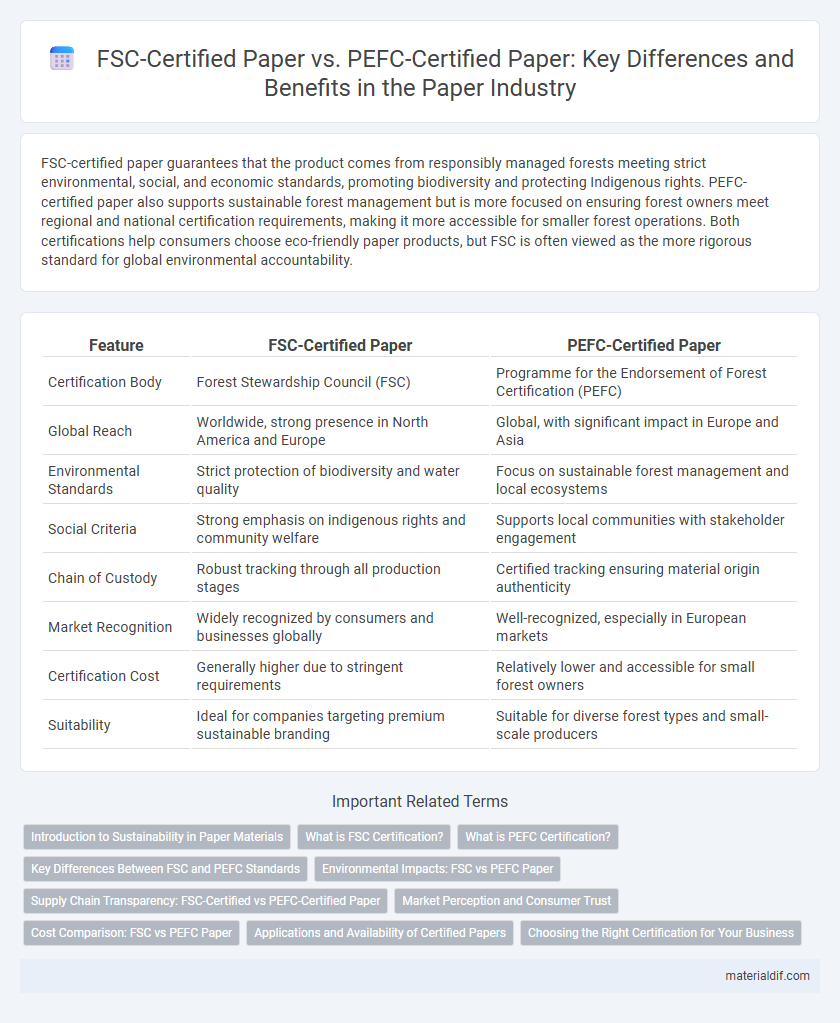FSC-certified paper guarantees that the product comes from responsibly managed forests meeting strict environmental, social, and economic standards, promoting biodiversity and protecting Indigenous rights. PEFC-certified paper also supports sustainable forest management but is more focused on ensuring forest owners meet regional and national certification requirements, making it more accessible for smaller forest operations. Both certifications help consumers choose eco-friendly paper products, but FSC is often viewed as the more rigorous standard for global environmental accountability.
Table of Comparison
| Feature | FSC-Certified Paper | PEFC-Certified Paper |
|---|---|---|
| Certification Body | Forest Stewardship Council (FSC) | Programme for the Endorsement of Forest Certification (PEFC) |
| Global Reach | Worldwide, strong presence in North America and Europe | Global, with significant impact in Europe and Asia |
| Environmental Standards | Strict protection of biodiversity and water quality | Focus on sustainable forest management and local ecosystems |
| Social Criteria | Strong emphasis on indigenous rights and community welfare | Supports local communities with stakeholder engagement |
| Chain of Custody | Robust tracking through all production stages | Certified tracking ensuring material origin authenticity |
| Market Recognition | Widely recognized by consumers and businesses globally | Well-recognized, especially in European markets |
| Certification Cost | Generally higher due to stringent requirements | Relatively lower and accessible for small forest owners |
| Suitability | Ideal for companies targeting premium sustainable branding | Suitable for diverse forest types and small-scale producers |
Introduction to Sustainability in Paper Materials
FSC-certified paper guarantees that the wood fibers come from responsibly managed forests that meet strict environmental, social, and economic standards, ensuring long-term forest health and biodiversity. PEFC-certified paper also promotes sustainable forest management through independent third-party certification, focusing on local ownership and community benefits. Both certifications contribute to reducing deforestation and promoting sustainable resource use in the paper industry.
What is FSC Certification?
FSC certification ensures that paper products come from responsibly managed forests meeting strict environmental, social, and economic standards set by the Forest Stewardship Council. This certification promotes forest preservation, encourages biodiversity conservation, and guarantees traceability throughout the supply chain. Compared to PEFC certification, FSC is globally recognized for its robust criteria and independent third-party audits ensuring sustainable forest management.
What is PEFC Certification?
PEFC Certification stands for Programme for the Endorsement of Forest Certification, which ensures that paper products come from sustainably managed forests with high environmental, social, and economic standards. Unlike FSC, PEFC operates through mutual recognition of national certification systems, promoting local forest management practices while maintaining global sustainability criteria. This certification guarantees traceability and responsible sourcing, making PEFC-certified paper a credible choice for eco-conscious consumers and businesses.
Key Differences Between FSC and PEFC Standards
FSC-certified paper ensures strict adherence to international forest management standards, emphasizing environmental impact reduction and social responsibility, while PEFC-certified paper focuses on sustainable forest management through a more flexible, nationally tailored approach. FSC certification is globally recognized for its rigorous chain-of-custody requirements and preference for natural forest conservation, whereas PEFC prioritizes supporting small forest owners and promoting local forest stewardship. The choice between FSC and PEFC often depends on specific supply chain transparency needs, regional forest management practices, and stakeholder environmental priorities.
Environmental Impacts: FSC vs PEFC Paper
FSC-certified paper ensures rigorous environmental standards by promoting responsible forest management, biodiversity conservation, and reducing carbon emissions through certified sourcing. PEFC-certified paper also supports sustainable forestry but tends to focus more on local forest management practices, which can vary in environmental rigor across regions. Studies indicate FSC certification often results in stronger environmental benefits due to stricter criteria on habitat preservation and ecosystem integrity.
Supply Chain Transparency: FSC-Certified vs PEFC-Certified Paper
FSC-certified paper offers stringent supply chain transparency through its rigorous Chain of Custody certification, ensuring every step from forest to final product is independently verified. PEFC-certified paper provides supply chain transparency as well but often emphasizes local sourcing and national systems, which might vary in strictness compared to FSC. Both certifications promote responsible sourcing, yet FSC generally maintains higher global standards for traceability and transparency across international supply chains.
Market Perception and Consumer Trust
FSC-certified paper is often perceived as more credible and environmentally responsible, leading to higher consumer trust compared to PEFC-certified paper. Studies show that consumers associate FSC certification with rigorous sustainability standards, enhancing brand reputation and purchasing decisions. Market analyses reveal that FSC-certified products frequently command premium pricing due to stronger consumer confidence and perceived value.
Cost Comparison: FSC vs PEFC Paper
FSC-certified paper typically incurs higher costs due to stricter environmental and social standards enforced during sourcing and production, leading to increased oversight and certification fees. PEFC-certified paper generally offers a more affordable option as it accommodates a broader range of forestry management practices and often targets regional, small-scale suppliers. Businesses seeking budget-friendly sustainable paper solutions often prefer PEFC certification, while those prioritizing rigorous sustainability criteria may opt for the more costly FSC-certified products.
Applications and Availability of Certified Papers
FSC-certified paper is widely used in industries such as printing, packaging, and publishing due to its strict environmental and social standards, ensuring traceability and sustainability throughout the supply chain. PEFC-certified paper, with a larger global supply base, offers greater availability, especially in Europe and Asia, making it suitable for mass-market products like notebooks, office paper, and promotional materials. Both certifications support responsible forest management, but FSC paper is often preferred for premium or environmentally sensitive applications, while PEFC paper meets broader market demands with competitive availability.
Choosing the Right Certification for Your Business
FSC-certified paper ensures stringent environmental and social standards, making it ideal for businesses prioritizing sustainability and transparency in their supply chain. PEFC-certified paper supports sustainable forest management with a focus on promoting local community benefits and small-scale forestry operations. Selecting between FSC and PEFC certification depends on your company's values regarding environmental responsibility, market demands, and stakeholder expectations.
FSC-certified paper vs PEFC-certified paper Infographic

 materialdif.com
materialdif.com